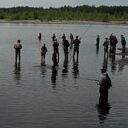

Salmon hatcheries artificially increase the salmon population and availability to southern residents. Increased hatchery production could significantly increase salmon population, but there could be some negative side effects. One side effect of increased hatchery production is increased land use, which could negatively affect the surrounding ecosystem and actually cause less salmon to be available to the southern residents.

All of the solutions to the overfishing of salmon have negative side effects, because fishing is very important to the local economy. If laws that limited or prevented the fishing of salmon were implemented, many people would lose their jobs, and subsistence fishers would no longer have food to feed themselves or their family. Due to these negative side effects, laws that further limit fishing would not be an acceptable solution for reduced prey population.
Contamination of the prey's water is a result of polluted water runoff and industrial chemicals. Filtering the water runoff could be expensive, but it would help prevent further water contamination and would have no negative side effects. Regulation of industrial chemicals would also help prevent further water contamination, but it could reduce pay for industrial workers because companies might have to spend more money to limit pollution. After either of these solutions are implemented, focus would need to shift to the cleanup of the already contaminated water.
As the effects climate change become increasingly apparent, there will naturally be more laws and regulations that help prevent and reverse it. This will increase the health of salmon, resulting in an increase in their population and availability to the southern residents.
As explained earlier, some solutions to water contamination are the filtering of water runoff, regulation of industrial chemicals, and cleanup of the contaminated water. In addition to increasing the salmon population, the prevention and cleanup of water contamination would also directly benefit the southern residents, because water contamination also directly affects them.
In order to prevent disruptive vessel sounds and vessel collisions with southern residents, laws that require a minimum distance between vessels and orcas would have to be implemented. If this were to happen, vessels would have to steer away from any southern resident orcas that they detect. This could make navigation quite difficult for vessels, but it would be very effective in the reduction of vessel sounds and would make vessel collisions with southern residents almost impossible.
Unfortunately, the whale watching industry relies on their vessels being very close to the southern residents, so whale watching would be much less popular if these laws were put into place. Whale watching also educates people about the southern residents and the problems that affect them, and the reduced popularity of whale watching would cause less people to care about the southern residents.
Most of the solutions described on this page can only be implemented by the government or companies, but there are also some ways that you can help too.

Next time that you're outside, make sure that the following things don't get into storm drains, as they can contaminate the water runoff:
If you see any garbage near storm drains, make sure to throw it into the trash.
If more people know about the southern residents and what's happening to them, the solutions to the problems that affect them will get more public approval, and new solutions might even be created. One way that you can tell other people about the southern residents is by sharing this website with them.
Recovery Plan for Southern Resident Killer Whales by the National Marine Fisheries Service, 2008
Center for Whale Research web site
All uncredited images and sounds are in the public domain.